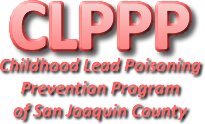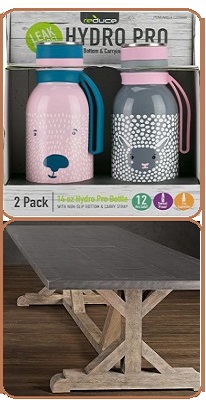Frequently Asked Questions
What are common sources of lead?
Why do you target children under the age of six?
How do I know if my child has lead poisoning?
Can lead poisoning be treated?
How can healthy foods protect my child from lead poisoning?
What are some simple steps to protect my child from lead poisoning?
What is lead poisoning?
Lead is a natural mineral that has been used in many products over the years. Lead poisoning occurs when lead builds up in the body, often over a period of months or years. There is no known safe level of lead in the body, and even small amounts can cause lifelong learning and behavior problems.
What are common sources of lead?
- Lead-based paint (pre-1978). It may have been used both inside and outside of a home. Children may eat paint chips or chew on the surfaces of windows, walls, doors, or railings. In San Joaquin County, about 63% of homes were built before 1978.
- Lead-contaminated soil. Lead may be in the soil where children play, especially near busy roadways or factories. The lead from gasoline used for many years has settled onto soil and is difficult to remove. This soil may also be tracked inside on shoes and clothing.
- Lead-contaminated dust from paint or soil. The dust clings to windowsills, floors, doorways and children’s toys, and is dangerous to young children who crawl and often put their hands and other objects in their mouths.
- Take-home exposure in the dust brought home on clothing, equipment, or in the car or truck driven from work. Lead dust can also come from hobbies that use lead.
Common Sources of Take Home Exposure
- Imported home remedies and imported cosmetics may contain lead. They often are imported from the Middle East, Southeast Asia, India, the Dominican Republic, or Mexico. The remedies are often bright yellow or orange in color. Examples include: Alarcon, Alkohl, Azarcon, Bali goli, Bint al zahab, Coral, Greta, Farouk, Ghasard, Kandu, Kohl, Liga, Litargirio, Lozeena, Pay-loo-ah, Sindoor, and Surma. There are many others.
- Imported or handmade pottery and tableware with leaded glaze. The lead from the glaze gets into food and beverages when these ceramics are used for cooking or storing food.
Lead in Traditional Ceramic Dishware
Why do you target children under the age of six?
Children under six years old and fetuses are at greatest risk of the harmful effects from lead poisoning:
- Their brains and nervous systems are still forming.
- They frequently crawl on floors or furniture contaminated with lead dust and put their hands or other objects in their mouths.
- More of the lead that gets into their mouth is taken up into their bodies.
- Much of the lead is stored in their bones.
- Lead can be measured in their blood and remains in their bodies for a long time.
How do I know if my child has lead poisoning?
Most children who have lead poisoning do not look or act sick. Symptoms, if present, may be confused with common childhood complaints such as stomachaches, crankiness, headaches, or loss of appetite. The only way to know if your child has lead poisoning is for the child to get a blood test for lead.
Children ages 12 months and 24 months who are enrolled in publicly funded health care programs such as Medi-Cal, Child Health and Disability Prevention Program (CHDP), the Supplemental Nutrition Program for Women, Infants and Children (WIC), or Healthy Families are at high risk and should be tested. Cost for the test is covered by government health programs and most health insurance plans.
If you are concerned your child may have been exposed to lead, or if you live in a pre‐1978 home that has been repaired/remodeled or has chipped/peeling paint, ask your child’s doctor about a blood lead test. You should also ask for a lead test if your child has a playmate or a family member with lead poisoning or you have a history of living in or visiting a country with high levels of environmental lead.
Can lead poisoning be treated?
- The most common way to treat lead poisoning in children is to find the lead source and remove it from the environment. Few children have high enough levels of lead in their blood that they require a medicine called a chelating agent. A chelating agent is a type of medicine that helps to remove the lead from the child’s body.
- Any other problems associated with lead poisoning, such as anemia, should be treated.
- A healthy diet is recommended.
How can healthy foods protect my child from lead poisoning?
A good diet can help prevent lead from getting into your child’s body. These suggestions provide your child with a healthy diet and also prevent lead from being absorbed into your child’s body. Your child should:
- Eat regular meals and healthy snacks (four to six times a day).
- Eat calcium-rich foods (cheese, milk, spinach, salmon, yogurt, tofu, and leafy greens).
- Eat iron-rich foods (lean red meat, chicken or turkey without skin, raisins, beans, oatmeal, and split peas).
- Eat vitamin C to help the body absorb iron (fruit juice, oranges, grapefruit, tomatoes, broccoli, kiwi, and strawberries).
- Reduce fatty foods such as fried foods, fast foods, and “junk” foods (donuts, potato chips, and cupcakes). However, some fat in the diet is very important for brain development, especially under age two. Examples of healthy fats include foods such as peanut or almond butter, avocado, baked or broiled oily fish such as salmon.
What are some simple steps to protect my child from lead poisoning?
- Wash your child’s hands and face frequently, especially after coming in from playing outside and before eating.
- Wash toys, countertops and windowsills and wet mop floors weekly with an all-purpose detergent.
- Feed your child regular meals with a diet high in calcium, iron, and vitamin C and low in fat. Well Fed = Less Lead
- Clean up paint chips and peeling paint safely. Remodeling or repairing a lead-painted home can release dangerous amounts of lead. Hire a contractor certified by the State of California to do lead work.
State-certified Lead Contractors
If you must do the work yourself, contact San Joaquin County’s Childhood Lead Poisoning Prevention Program at 209-468-2593 for information on how to do the work safely. Renovate Right and Repainting or Fixing Up Your Older Home provide additional lead hazard information.
- Keep furniture away from damaged paint. Pay special attention to cribs, beds, highchairs, and playpens.
- Allow cold water to run for a few minutes in the morning before using it for drinking, cooking, or mixing formula in case there may be lead in your household pipes. Do not use hot water from the tap for drinking or in food preparation.
- Avoid using handmade, older, or imported dishes for food or drink preparation, storage, or serving, unless you are sure they do not contain lead.
- Avoid using imported home remedies or cosmetics that contain lead. If you are not sure, contact San Joaquin County’s Childhood Lead Poisoning Prevention Program at 209-468-2593.
- Take off your shoes before entering the house. Or use a doormat to wipe shoes off – this will help prevent lead dust and soil from getting into your house.
- Don’t let your child play in areas where bare soil is exposed.
- Vacuum carpets frequently to reduce household dust, using a vacuum with a HEPA filter.
- If you work with lead at your job, learn how to prevent your child from becoming lead poisoned.
Don’t Take Lead Home from Your Job
- Before remodeling, ask a trained professional to test the paint in your house. If lead is in the paint, learn how to handle it safely.
Testing Your Home for Lead in Paint or Soil




 Information
Information